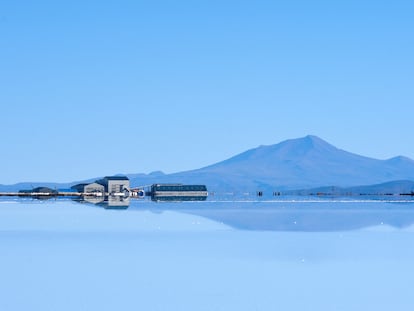The rise of lithium mining threatens the Andean flamingo in Argentina
The mining boom — which is concentrated in the provinces of Salta, Jujuy and Catamarca — is affecting this species’ nesting places. There are less than 80,000 of these beautiful flamingos left
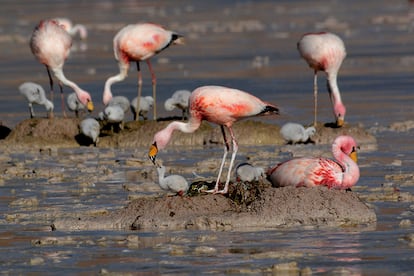
The Andean flamingo has an elegant stride, with a grace that hypnotizes you. Its plumage is impressive: a mix of hot pink, white and black.
Reaching more than three feet in height, these creatures nest in colonies during the summer, in the shallow wetlands of Puna — the Atacama Plateau — and the Andes of Chile, Bolivia and Argentina. This area is also known as the “lithium triangle.”
In Argentina, the rarest of all flamingo species is found mostly in the northern provinces — Salta, Catamarca and Jujuy — during the warmer months. These birds can also be found in the center of the country, mainly in Córdoba and Santa Fe. According to the National Mining Secretariat, there are 38 lithium projects in the country, of which 17 are in the large salt flats of the province of Salta.
For some years now, biologists and conservation specialists have been warning about the negative impacts of the exploitation of lithium brine deposits in the places where these animals reproduce and feed. This species of bird from the flamingo family (in Argentina, there are also specimens of the Southern flamingo and James’s flamingo) has been classified as “vulnerable” by the International Union for Conservation of Nature (IUCN).
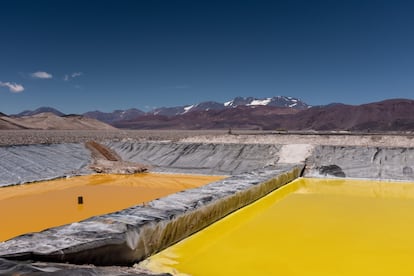
For years, Enrique Derlindati — a professor of Biological Sciences at the National University of Salta — has been researching these birds, their population trends and the threats they face in their environment. He underscores the need for measures to preserve their survival and reproductive capacity.
“In the summer, these species move to the mountain range — especially wetlands and salt flats — which are 13,000 feet above sea level. There, they make their nesting colonies, which are increasingly difficult to find and which overlap with the so-called lithium triangle. The Andean flamingo is a species that’s restricted to the Andes and has the smallest population size. In censuses, it’s estimated that there are around 80,000 specimens in all of South America. They’ve stopped using historical nesting sites due to the presence of lithium exploration,” Derlindati laments. He has been studying flamingos since the 1990s.
These numbers arise from the sixth census of three species of flamingos in the Southern Cone, carried out by Argentina’s National Scientific and Technical Research Council (CONICET), together with other socio-environmental research and conservation institutions. “It’s a follow-up and monitoring process that’s carried out on the population every five years. Over the last 15 years, we began to observe fewer juveniles in natural environments. That’s a big warning sign. Mining companies are being installed in all the salt flats of the Puna; they’re not leaving a single one untouched. This restricts nesting possibilities, because Andean flamingos look for isolated sites,” the specialist adds.
Derlindati believes that mining activity could be carried out with less environmental impact in Argentina, while taking into account the local fauna. “I had the opportunity to be in Chile. There, for example, the miners don’t carry out their tasks during the species’ nesting periods, between November and February. But if the mining companies don’t want to stop and the governments don’t want to stop, it’s difficult to enforce this. There are also other ways to extract lithium. Here, [in Argentina], it’s done with drying basins, because it’s the most economical method. This requires a transformation of the salt flat system. The direct impact of the [extractivist] activity is very great,” he affirms.
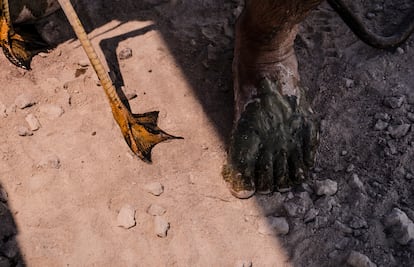
Matías Michelutti is a tour guide in the Ansenuza National Park, in the province of Córdoba. This park is home to the largest salt lake in South America and 66% of all species of migratory and shorebirds recorded in Argentina, including the Andean flamingos, who choose the area in the wintertime.
Michelutti knows the place like the back of his hand: his father was a park ranger and his family navigated its waters for more than 40 years.
“The big problem is water. The conservation of the sites and the provision of food are subject to environmental conditions and the water levels. In these years of drought — from 2019 to December of last year — the lagoon shrank to historical levels that were only seen in the 1970s. The number of Southern flamingos is stable and isn’t at risk, but the Andean flamingos — while nesting and feeding — rely on the same sites where lithium extraction is currently carried out, or will be carried out in the near future,” Michelutti explains.
This is a big problem. “It’s not the extraction of lithium per se, but the use of water for that process,” the tour guide warns. Like Derlindati, he’s part of the High Andean Flamingo Conservation Group (GCFA), which includes scientists and conservationists from Argentina, Bolivia, Chile and Peru.
The Ansenuza National Park was classified as a protected area in 2022. Michelutti highlights this legal framework for conservation, after long years of research and dissemination work to publicize the enormous wetland of about 3,000 square miles, located in the central-north region of Argentina. “It was a long road and a milestone to become a national park. Worldwide, the trend is for these environments to dry out. With tourism, we want the general public to learn about the importance of these wetlands,” he says.
Protective measures and stricter regulations to curb environmentally harmful activities are part of the national conversation. In Argentina, Law 24.585 — dealing with environmental protections required of mining activities — provides a “regulatory framework for protection.” However, the approval or denial of permits to carry out mining projects depends on each province. Regional authorities have control over their resources, as indicated in Article 124 of the Constitution.
Derlindati warns that the environmental impacts are exacerbated by the lack of data provided by mining companies and the lax controls implemented by the provincial governments. “In many cases, mining companies don’t provide data, because the state doesn’t require it. The economic situation causes them to destroy natural assets, following a false remedy for the lithium fever. For example, in Salta, the provincial legislature seeks to reduce bureaucracy to facilitate mining exploitation, meaning that they’re lax with permits and restrictions. The cost always ends up being environmental and taking a toll on people’s health,” he analyzes.
“The environmental impact study is complete: it includes air, soil, land and social aspects. What environmentalists say are opinions… [they’re not offering] firm data from an official body,” responds Simón Pérez Alsina, president of the Chamber of Mining in Salta, the province with the largest number of lithium projects in the country.
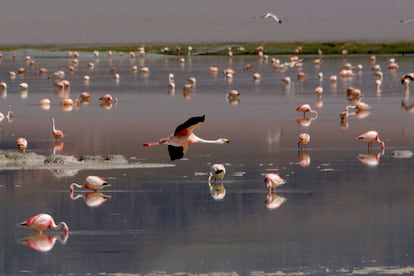
The mining executive says that the Puna of Argentina is a territory “that has millions of hectares,” with large areas to carry out productive ventures while still conserving flora and fauna. “Any human activity produces an impact, even building a house. Technically, there’s no proven negative impact of any lithium project. There’s no pollution nor lack of water nor decline in species. Lithium is the mineral of the energy transition. Without lithium, we won’t decarbonize the world.”
However, a 2021 study published by the Humedales Foundation, with support from the NGO Wetlands International — Environmental impact of lithium exploitation on wetlands and water resources in the Andean Plateau — warns of documented and identified impacts, such as salinization of soils and wetlands, contamination of soils with hazardous waste, modification of the natural surface flow of water, alteration of the water balance and impact on native flora and fauna.
The immense salt flats of northern Argentina aren’t just the “white gold” of lithium. They’re located in a fragile environment that — according to the aforementioned study and the voices of other specialists — still doesn’t have an effective environmental monitoring network to quantify the impact. The challenge is to evaluate the feasibility of developing environmentally-sustainable projects.
Without taking protective measures, the large desert landscapes and their bodies of water will be irreversibly transformed. The problem is further aggravated with the recent election of Javier Milei, who denies climate change, as president of Argentina.
Derlindati sums the issue up with one sentence: “The Puna is a complex and fragile system. When we start breaking links and putting human elements into the environment, everything starts to go wrong. And it’s difficult to predict the results that this will have in the future.”
Sign up for our weekly newsletter to get more English-language news coverage from EL PAÍS USA Edition
Tu suscripción se está usando en otro dispositivo
¿Quieres añadir otro usuario a tu suscripción?
Si continúas leyendo en este dispositivo, no se podrá leer en el otro.
FlechaTu suscripción se está usando en otro dispositivo y solo puedes acceder a EL PAÍS desde un dispositivo a la vez.
Si quieres compartir tu cuenta, cambia tu suscripción a la modalidad Premium, así podrás añadir otro usuario. Cada uno accederá con su propia cuenta de email, lo que os permitirá personalizar vuestra experiencia en EL PAÍS.
¿Tienes una suscripción de empresa? Accede aquí para contratar más cuentas.
En el caso de no saber quién está usando tu cuenta, te recomendamos cambiar tu contraseña aquí.
Si decides continuar compartiendo tu cuenta, este mensaje se mostrará en tu dispositivo y en el de la otra persona que está usando tu cuenta de forma indefinida, afectando a tu experiencia de lectura. Puedes consultar aquí los términos y condiciones de la suscripción digital.
More information
Archived In
Últimas noticias
Chris Martin, Taylor Swift, Elijah Wood and other famous wedding ‘crashers’
‘How does it feel to be a failure?’: Elizabeth Berkley’s journey from ‘Showgirls’ ridicule to vindication
The story of the Málaga virus: The code that haunted Google’s cybersecurity center director for 30 years
The impact of Ecuador’s mega-prison: A polluted river, cleared forests and military checkpoints
Most viewed
- Christian Louboutin: ‘Young people don’t want to be like their parents. And if their parents wear sneakers, they’re going to look for something else’
- The low-cost creative revolution: How technology is making art accessible to everyone
- Liset Menéndez de la Prida, neuroscientist: ‘It’s not normal to constantly seek pleasure; it’s important to be bored, to be calm’
- All the effects of gentrification in one corner of Mexico’s Colonia Roma
- December Social Security and SSI payments: Dates, double checks and the 2026 COLA increase

